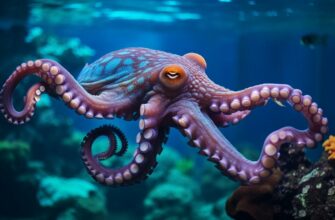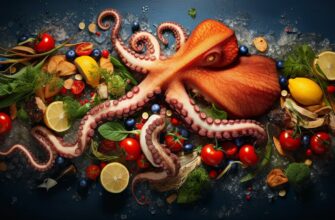Welcome to the world of octopuses, one of the most fascinating creatures that inhabit the oceans. Octopuses are widely known for their unique abilities, including camouflage, intelligence, and regeneration of lost body parts. But one question that often comes up is whether octopuses shed their skin, just like other animals. In this article, we’ll explore the world of octopus physiology and discover the truth behind skin shedding.
- Understanding Octopus Physiology
- Anatomy and Physiology of Octopuses
- The Importance of Skin for Octopuses
- The Shedding Process: Molting
- Variations in Molting Frequency
- Factors Affecting Skin Shedding
- Internal Factors
- External Factors
- Octopuses and Regeneration of Lost Body Parts
- The Challenges of Octopus Skin Shedding in Captivity
- FAQ – Frequently Asked Questions about Octopus Skin Shedding
- Do all octopuses shed their skin?
- How often do octopuses shed their skin?
- Is shedding necessary for octopus survival?
- How is the shedding process initiated?
- What happens to the old skin after shedding?
- Can shedding be influenced by environmental factors?
- What should I do if I notice irregular shedding in my pet octopus?
Understanding Octopus Physiology
Octopuses are fascinating creatures with unique physical characteristics that allow them to inhabit a variety of aquatic environments. They lack a rigid skeletal structure, which makes them incredibly flexible and enables them to squeeze into tight spaces. Additionally, they have soft bodies that are covered in skin.
Their skin is an essential component of their physiology, serving numerous functions that contribute to their overall survival. For instance, it provides protection against predators and ensures that they blend seamlessly into their surroundings through camouflage. Skin also facilitates communication between octopuses using color and texture changes, and some species can even secrete toxins through their skin.
Furthermore, octopuses shed their skin periodically, which is a crucial aspect of their physiology. Shedding helps them maintain healthy skin that is free of damaged or dead tissue, allowing for optimal function.
Anatomy and Physiology of Octopuses
Before delving into the specifics of skin shedding, it is essential to understand some aspects of octopus anatomy and physiology. Octopuses are mollusks, which means they belong to the same group as snails, slugs, and clams. However, unlike other mollusks, octopuses lack a shell.
They have a head, a mantle, and eight tentacles, all of which are covered in skin. Additionally, they have two eyes and a beak-like mouth that is located in the center of their arms.
Octopuses have a complex nervous system that enables them to solve problems and exhibit behavior that resembles that of higher vertebrates. They also have three hearts, which pump blue blood through their bodies. Their blood contains copper, which gives it a blue color instead of the red color that is typical of most vertebrate blood.
Because they lack a rigid skeletal structure, octopuses can change shape rapidly and dramatically. They can also change color and texture, allowing them to blend seamlessly with their environment. These features make them incredibly effective predators and contribute to their unique physiology.
The Importance of Skin for Octopuses
Octopuses have a distinctive relationship with their skin, which serves multiple essential functions. Not only does it provide protection from predators, but it also aids in communication, camouflage, and the secretion of toxins. Their skin is a complex and dynamic organ that plays a vital role in their survival.
One of the primary functions of octopus skin is to provide camouflage, allowing it to blend in with its surroundings. The skin contains specialized cells called chromatophores that can expand and contract, changing the skin’s color and texture to match the surrounding environment. This ability makes octopuses masters of disguise, and it is critical to their survival.
In addition to camouflage, octopus skin is also responsible for toxin secretion. Some species of octopuses can produce venom that is potent enough to kill prey or defend against predators. Their skin contains specialized cells called papillae that produce and secrete these toxins. This ability to produce venom is a testament to the complexity of their skin.
Finally, the skin also plays a role in communication. Octopuses are solitary creatures, but they use their skin to communicate with each other through color changes and patterns. This communication is essential during mating, where they use their skin to signal readiness and attract a mate.
The Shedding Process: Molting
Octopuses undergo a shedding process known as molting, where they shed their skin to allow for the growth of a new layer. This process is necessary for their survival and ensures that their skin remains healthy and functional. The stages of the shedding process involve the growth of a new skin layer, followed by the formation of a cuticle, and ultimately the shedding of the old skin.
During the growth stage, the octopus will begin to produce a new layer of skin beneath the old one. As the new layer grows, it will start to push against the old skin, causing it to loosen and separate. This results in the formation of a thin layer known as the cuticle, which acts as a barrier between the old and new skin.
Once the cuticle has formed, the old skin will begin to peel away from the new layer in a process called ecdysis. The octopus will use its suckers to grip onto objects and peel the old skin away, starting from the head and working backwards. The final stage involves the shedding of the old skin, which is typically done in small pieces, rather than all at once.
Variations in Molting Frequency
The frequency of molting varies among different octopus species and can be affected by a range of factors, such as water temperature, food availability, and reproductive state. Some species may molt several times a year, while others may only molt once or twice in their lifetime. Younger octopuses tend to molt more frequently than adults as they are still growing and developing.
In captivity, the shedding process can be affected by environmental conditions, such as tank maintenance and diet. Providing appropriate conditions and diet for octopuses in captivity is crucial for their health and wellbeing, as well as ensuring healthy skin shedding.
Factors Affecting Skin Shedding
Octopuses shed their skin at varying intervals, and several factors can influence this process. The shedding frequency can depend on both internal and external factors.
Internal Factors
One important internal factor that affects skin shedding is the octopus’ growth rate. Juvenile octopuses tend to molt more frequently than adults due to their faster growth rate. Reproductive state also plays a role, with female octopuses molting less frequently during egg-laying periods.
External Factors
Environmental factors such as temperature, food availability, and overall health can affect an octopus’ skin shedding process. Stressful conditions can also cause an octopus to shed its skin prematurely, as a defensive mechanism to get rid of any parasites or bacteria that might be present.
Another external factor that can affect skin shedding is the octopus’ natural habitat. Octopuses living in deeper waters tend to molt less frequently than those in shallower waters. This is likely due to the lower temperatures and decreased food availability in deeper waters.
Octopuses and Regeneration of Lost Body Parts
Octopuses are unique creatures that have a remarkable ability to regenerate lost body parts. This includes their skin, which they shed as part of their natural growth process. Skin shedding, also known as molting, is an essential function that allows the octopus to maintain healthy skin and survive in the wild.
Unlike humans and other mammals, octopuses have a soft body and lack a rigid skeleton. This contributes to their ability to regenerate lost body parts, including their skin. When an octopus sheds its skin, it goes through a process of growth and renewal, which allows it to regenerate any damaged or lost skin tissue.
The process of skin shedding begins with the growth of a new skin layer under the old one. As the new layer grows, the old skin becomes thinner and forms a cuticle that covers the soft tissues. The octopus then breaks free of the old skin, leaving behind the cuticle and revealing the fresh, healthy layer underneath.
While the process of skin shedding is essential for octopus survival, it can vary depending on species, environmental factors, and internal conditions. For example, some octopus species may shed their skin more frequently than others, while others may shed less often. Additionally, environmental factors such as temperature, water quality, and food availability can also affect the skin shedding process.
Overall, the ability of octopuses to regenerate lost body parts, including their skin, is a fascinating aspect of their physiology. It allows them to adapt to changes in their environment and maintain healthy tissues throughout their lives.
The Challenges of Octopus Skin Shedding in Captivity
While octopuses are expert skin shedders in the wild, this process can be challenging in captivity. Octopuses rely on environmental cues, including temperature, light, and even lunar cycles, to regulate their shedding. In captivity, however, these cues may be disrupted by the artificial conditions of their tanks.
Tank maintenance is a critical factor in supporting healthy skin shedding for octopuses in captivity. Tanks should be kept clean, and water quality must be maintained at optimal levels. Additionally, water flow and filtration systems should be appropriate for the size of the tank and the number of octopuses kept within it. Poor water quality or inadequate filtration can lead to skin irritation and infection.
Diet can also affect skin shedding for captive octopuses. A balanced and varied diet that meets the nutritional needs of the octopus is essential for good health and proper skin shedding. Overfeeding or underfeeding can disrupt the shedding process and lead to complications, such as improper enzyme production or a lack of essential nutrients.
Finally, stress can impact the skin shedding process for captive octopuses. Stressors can include changes to their environment, such as the introduction of new tankmates, or handling by humans. These stressors can trigger premature shedding, which can be harmful to the octopus’s health.
In conclusion, the challenges of skin shedding for octopuses in captivity can be mitigated by careful attention to tank maintenance, diet, and stress reduction. Providing suitable conditions can ensure that octopuses are healthy and thriving, and able to shed their skin effectively.
FAQ – Frequently Asked Questions about Octopus Skin Shedding
Here are some common questions related to octopus skin shedding:
Do all octopuses shed their skin?
Yes, all octopuses shed their skin throughout their lifespan.
How often do octopuses shed their skin?
The frequency of skin shedding varies among octopus species, but most shed their skin every few weeks to several months.
Is shedding necessary for octopus survival?
Yes, shedding is necessary for the growth and health of octopuses. It allows them to get rid of old and damaged skin and replace it with new skin that can provide protection and other important functions.
How is the shedding process initiated?
The shedding process is initiated by hormonal changes in octopuses that result in the formation of a cuticle layer under their skin. This cuticle layer will eventually separate the old skin from the new one.
What happens to the old skin after shedding?
The old skin is typically consumed by octopuses, as it contains important nutrients and proteins that can benefit their health and growth.
Can shedding be influenced by environmental factors?
Yes, environmental factors like temperature, food availability, and water quality can influence the frequency and success of skin shedding in octopuses.
What should I do if I notice irregular shedding in my pet octopus?
If you notice irregular shedding, it is best to consult a veterinarian or a qualified octopus expert who can assess the health of your pet and provide appropriate care and treatment.









